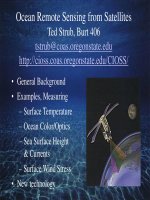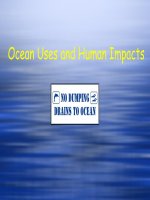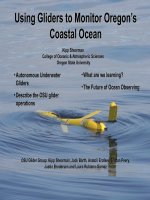Geography and Oceanography - Chapter 12 ppsx
Bạn đang xem bản rút gọn của tài liệu. Xem và tải ngay bản đầy đủ của tài liệu tại đây (6.44 MB, 28 trang )
Ocean Acidification and the
Ocean Acidification and the
Future Global Carbon Cycle
Future Global Carbon Cycle
•
Rising atmospheric CO
2
•
Ocean’s role in uptake of atmospheric CO
2
•
Resulting changes in ocean chemistry
•
Possible outcomes for future oceans
•
What can we can do to help improve the future?
Jack Barth ()
College of Oceanic & Atmospheric Sciences
for further info: “The Future of Ocean Biogeochemistry in a High
CO2 World,” Oceanography magazine (Dec. 2009)
/>Data from Keeling and Whorf, 2004
Rising Atmospheric CO
2
was first discovered by Dr.
David Keeling in the mid 1900s.
Atmospheric CO
2
Record
Northern
Hemisphere has
larger seasonal
variability than
southern hemisphere
Atmospheric CO
2
levels are rising
everywhere in the world. This can easily
be seen even with the natural variability.
Atmospheric CO
2
was steady for at least 1,000 years
before the industrial revolution.
“It is very likely that [man-made]
greenhouse gas increases caused most
of the average temperature increase
since the mid-20 century”
-
Intergovernmental Panel on Climate
Change (IPCC) 4th Assessment
Report (2007)
Antarctic Ice Core Record
-10
20
15
10
5
0
-5
450 400 350 300 250 200 150 100 50 0
Thousands of years BP (before present)
Temperature change (°C)
CO
2
concentration
Temperature change (°C)
200
400
CO
2
Concentration (ppmv)
0
550
800
2050
2100
Recent emissions
1990 1995 2000 2005 2010
CO
2
Emissions (GtC y
-1
)
5
6
7
8
9
10
Actual emissions: CDIAC
Actual emissions: EIA
450ppm stabilisation
650ppm stabilisation
A1FI
A1B
A1T
A2
B1
B2
1850 1900 1950 2000 2050 2100
CO
2
Emissions (GtC y
-1
)
0
5
10
15
20
25
30
Actual emissions: CDIAC
450ppm stabilisation
650ppm stabilisation
A1FI
A1B
A1T
A2
B1
B2
50-year constant
growth rates
to 2050
B1 1.1%,
A1B 1.7%,
A2 1.8%
A1FI 2.4%
Observed
2000-2006
3.3%
2007
2006
Recent emissions have been higher than the
worst of the IPCC projected scenarios
GigatonsC/year
Year
Carbon Inventories of Reservoirs that Naturally
Exchange Carbon on Time Scales of Decades to Centuries
Ocean
38,136 PgC
Soil=2300 PgC
Plants=650 PgC
Atm.=775 PgC
Preind.
Atm. C
=76%
Ocean Anth.
C=0.35%
•
Oceans contain ~90% of carbon in this 4 component system
•
anthropogenic component is difficult to detect
Anth.
C=24%
In the 1990s we conducted a global survey of CO
2
in the
oceans to learn how much fossil fuel is stored in the ocean.
~72,000 sample locations
collected in the 1990s
DIC ± 2 µmol kg
-1
TA ± 4 µmol kg
-1
Penetration of human-caused CO
2
into Ocean
•
Present-day levels minus pre-
industrial (year 1800)
•
Equivalent to about half of all
historical fossil fuel emissions
Sabine et al. (Science, 2004)
After Turley et al., 2005
Rising atmospheric CO
2
is changing the chemistry of the ocean
pH
CO
2
+ H
2
O H
2
CO
3
HCO
3
2-
+ H
+
CO
3
-
+ H
+
CO
2
is an acid gas so the addition of 22 million tons of
carbon dioxide to the ocean every day is acidifying the
seawater…we call this process “ocean acidification”
Feely et al. (2009)
Ocean Measurements of pCO
2
and pH
Ocean Acidification
calcium +
calcium +
carbonate
carbonate
calcium
calcium
carbonate
carbonate
Saturation State =
Ω
phase
Ω > 1 =
precipitation
Ω = 1 =
equilibrium
Ω < 1 =
dissolution
CO
2
+ CO
3
2-
+ H
2
O 2HCO
3
-
⇔
=
[Ca
2+
] [CO
3
2-
]
K*
sp, phase
Ca
2+
+ CO
3
2-
CaCO
3
→
→
Photos courtesy Katie Fagan
-50
50
100
150
200
050100150200250300350400450
Carbonate ion concentration (µmol kg
-1
)
Coral Calcification rate
mmol m
-2
d
-1
Net Dissolution
Net
Calcification
1870
280
2006
380
Low CO
2
High CO
2
-50
50
100
150
200
0
0
CO
2
level in
Atmosphere
(ppm)
Glacial
180
560
CO
CO
2
2
2X
2X
840
CO
CO
2
2
3X
3X
There appears to be a linear decrease in the calcification rate of
coral reef systems with decreasing carbonate ion concentrations in
Biosphere 2 Corals
Langdon & Atkinson, (2005)
R
2
= 0.843
Time
Predictions of Ocean Acidification and
the effects on coral reef calcification
Coral Reef
calcification
•
1765 Adequate
•
2000 Marginal
•
2100 Low
After Feely et al (in press) with Modeled Saturation Levels from Orr et al (2005)
Calcification
rates in the
tropics may
decrease by
30% over the
next century
Predictions of Ocean Acidification and
the effects on coral reef calcification
After Feely et al (in press) with Modeled Saturation Levels from Orr et al (2005)
Coral Reef
calcification
•
1765 Adequate
•
2000 Marginal
•
2100 Low
p
CO
2
280-380 ppmv
p
CO
2
780-850 ppmv
Emiliania huxleyi
Gephyrocapsa oceanica
Coccolithophores
Riebesell et al.(2000); Zondervan et al.(2001)
Manipulation of CO
2
system by addition of HCl or NaOH
Calcification
decreased
- 9 to 18%
- 45%
The shells of living pteropods begin to dissolve
at elevated CO
2
levels
C. pyramidata
Limacina helicina
Whole shell:
Clio pyramidata
Arag. rods exposed
Prismatic layer
(1 µm) peels back
Aperture (~7 µm):
advanced dissolution
Normal shell: unexposed
to undersaturated water
(Orr et al., 2005)
Micrographs from Victoria Fabry, CSUSM
Potential Effects on Open Ocean Food Webs
Barrie Kovish
Vicki Fabry
Pacific Salmon
Copepods
Coccolithophores
Pteropods
Pteropods make up 45% of the pink salmon diet
amphipods (likely also affected by OA) make up 32% of diet
Much of our present knowledge stems from
abrupt CO
2
/pH perturbation experiments
with single species/strains
under short-term incubations
with often extreme pH changes
and sensitivity to CO
2
/pH perturbation
Hence, we know little about
responses of genetically diverse populations
synergistic effects with other stress factors
physiological and micro-evolutionary adaptations
species replacements
community to ecosystem responses
impacts on global climate change
What we know about the biological impacts of ocean
acidification
CENOZOIC MESOZOIC PALEOZOIC PRECAMBRIAN
Age (Ma)
From Signor (1990)
Number of
Genera
65 200 251 360 444
Cretaceous/
Tertiary
Triassic/
Jurassic
Permian/
Triassic
Late
Devonian
Ordovician/
Silurian
Era
Coral Reef Gap
Where will the future take us?
CO
2
levels have been higher in the past,
But with every major rise there have been mass extinctions
How will these changes affect the global
carbon cycle in the future?
Carbon Cycle Change Climate Feedback direction
CO
3
2-
decrease Less efficient uptake positive
Calcification decrease lower natural CO
2
production negative
CaCO
3
dissolution-sed. higher CO
3
2-
increasing uptake negative
CaCO
3
dissolution-water higher CO
3
2-
/lower org. transport Neg./pos.
Increasing SST Convert ocean HCO
3
-
to CO
2
positive
Increased stratification Reduced mixing and transport positive
Increased stratification Lower productivity and uptake positive
Increased dust input Increased productivity-N fixers negative
Ecosystem structure Lower or higher productivity Pos./neg.
S
i
n
k
i
n
g
O
r
g
a
n
i
c
D
e
b
r
i
s
Present Ocean Food Web – Complex ecosystem interactions based on a low CO
2
ocean
Microbial Remineralization
Primary Producers
Z
o
o
p
l
a
n
k
t
o
n
f
o
o
d
w
e
b
U
p
p
e
r
T
r
o
p
h
i
c
l
e
v
e
l
s
Seafloor community
Simplified Food Web,
Increased Microbial Dominance
Provided by James Barry MBARI
Future Ocean Food Web – Simpler, more primitive ecosystem based on a high CO
2
ocean
Acidic waters
brought near the
coast by coastal
upwelling
Possible changes to:
•
species composition &
abundances
•
food webs
•
biogeochemical cycles
Feely et al. (2008)
hypoxic
Aug & Sep
Courtesy of MI_LOCO
(Barth, Adams, Chan)
Dissolved oxygen
and pCO
2
measured
off Oregon









